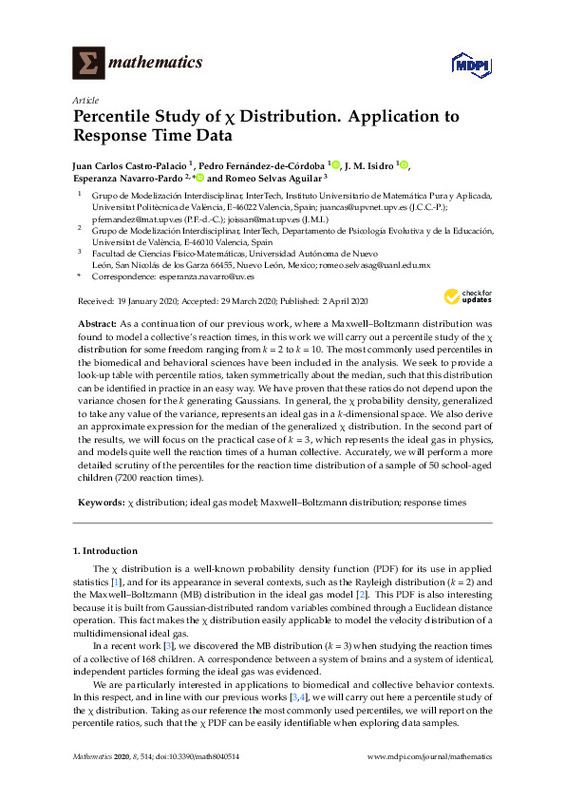JavaScript is disabled for your browser. Some features of this site may not work without it.
Buscar en RiuNet
Listar
Mi cuenta
Estadísticas
Ayuda RiuNet
Admin. UPV
Percentile Study of Chi Distribution. Application to Response Time Data
Mostrar el registro sencillo del ítem
Ficheros en el ítem
| dc.contributor.author | Castro-Palacio, Juan Carlos
|
es_ES |
| dc.contributor.author | Fernández de Córdoba, Pedro
|
es_ES |
| dc.contributor.author | Isidro, J.M.
|
es_ES |
| dc.contributor.author | Navarro-Pardo, Esperanza
|
es_ES |
| dc.contributor.author | Selvas Aguilar, Romeo
|
es_ES |
| dc.date.accessioned | 2021-09-10T03:30:53Z | |
| dc.date.available | 2021-09-10T03:30:53Z | |
| dc.date.issued | 2020-04 | es_ES |
| dc.identifier.uri | http://hdl.handle.net/10251/171998 | |
| dc.description.abstract | [EN] As a continuation of our previous work, where a Maxwell-Boltzmann distribution was found to model a collective's reaction times, in this work we will carry out a percentile study of the Chi distribution for some freedom ranging from k = 2 to k = 10. The most commonly used percentiles in the biomedical and behavioral sciences have been included in the analysis. We seek to provide a look-up table with percentile ratios, taken symmetrically about the median, such that this distribution can be identified in practice in an easy way. We have proven that these ratios do not depend upon the variance chosen for the k generating Gaussians. In general, the Chi probability density, generalized to take any value of the variance, represents an ideal gas in a k-dimensional space. We also derive an approximate expression for the median of the generalized Chi distribution. In the second part of the results, we will focus on the practical case of k = 3, which represents the ideal gas in physics, and models quite well the reaction times of a human collective. Accurately, we will perform a more detailed scrutiny of the percentiles for the reaction time distribution of a sample of 50 school-aged children (7200 reaction times). | es_ES |
| dc.description.sponsorship | This research was supported by grant no. RTI2018-102256-B-I00 (Spain). | es_ES |
| dc.language | Inglés | es_ES |
| dc.publisher | MDPI AG | es_ES |
| dc.relation.ispartof | Mathematics | es_ES |
| dc.rights | Reconocimiento (by) | es_ES |
| dc.subject | Chi distribution | es_ES |
| dc.subject | Ideal gas model | es_ES |
| dc.subject | Maxwell-Boltzmann distribution | es_ES |
| dc.subject | Response times | es_ES |
| dc.subject.classification | MATEMATICA APLICADA | es_ES |
| dc.subject.classification | FISICA APLICADA | es_ES |
| dc.title | Percentile Study of Chi Distribution. Application to Response Time Data | es_ES |
| dc.type | Artículo | es_ES |
| dc.identifier.doi | 10.3390/math8040514 | es_ES |
| dc.relation.projectID | info:eu-repo/grantAgreement/AEI/Plan Estatal de Investigación Científica y Técnica y de Innovación 2017-2020/RTI2018-102256-B-I00/ES/TRANSFERENCIA DE CALOR EN FLUJOS DE PARED: CANALES Y CAPAS LIMITES/ | es_ES |
| dc.rights.accessRights | Abierto | es_ES |
| dc.contributor.affiliation | Universitat Politècnica de València. Departamento de Matemática Aplicada - Departament de Matemàtica Aplicada | es_ES |
| dc.contributor.affiliation | Universitat Politècnica de València. Departamento de Física Aplicada - Departament de Física Aplicada | es_ES |
| dc.contributor.affiliation | Universitat Politècnica de València. Instituto Universitario de Matemática Pura y Aplicada - Institut Universitari de Matemàtica Pura i Aplicada | es_ES |
| dc.description.bibliographicCitation | Castro-Palacio, JC.; Fernández De Córdoba, P.; Isidro, J.; Navarro-Pardo, E.; Selvas Aguilar, R. (2020). Percentile Study of Chi Distribution. Application to Response Time Data. Mathematics. 8(4):1-7. https://doi.org/10.3390/math8040514 | es_ES |
| dc.description.accrualMethod | S | es_ES |
| dc.relation.publisherversion | https://doi.org/10.3390/math8040514 | es_ES |
| dc.description.upvformatpinicio | 1 | es_ES |
| dc.description.upvformatpfin | 7 | es_ES |
| dc.type.version | info:eu-repo/semantics/publishedVersion | es_ES |
| dc.description.volume | 8 | es_ES |
| dc.description.issue | 4 | es_ES |
| dc.identifier.eissn | 2227-7390 | es_ES |
| dc.relation.pasarela | S\406901 | es_ES |
| dc.contributor.funder | AGENCIA ESTATAL DE INVESTIGACION | es_ES |
| dc.description.references | Hernaiz-Guijarro, M., Castro-Palacio, J. C., Navarro-Pardo, E., Isidro, J. M., & Fernández-de-Córdoba, P. (2019). A Probabilistic Classification Procedure Based on Response Time Analysis Towards a Quick Pre-Diagnosis of Student’s Attention Deficit. Mathematics, 7(5), 473. doi:10.3390/math7050473 | es_ES |
| dc.description.references | Levenberg, K. (1944). A method for the solution of certain non-linear problems in least squares. Quarterly of Applied Mathematics, 2(2), 164-168. doi:10.1090/qam/10666 | es_ES |
| dc.description.references | Marquardt, D. W. (1963). An Algorithm for Least-Squares Estimation of Nonlinear Parameters. Journal of the Society for Industrial and Applied Mathematics, 11(2), 431-441. doi:10.1137/0111030 | es_ES |
| dc.description.references | World Medical Association Declaration of Helsinki. (2013). JAMA, 310(20), 2191. doi:10.1001/jama.2013.281053 | es_ES |








